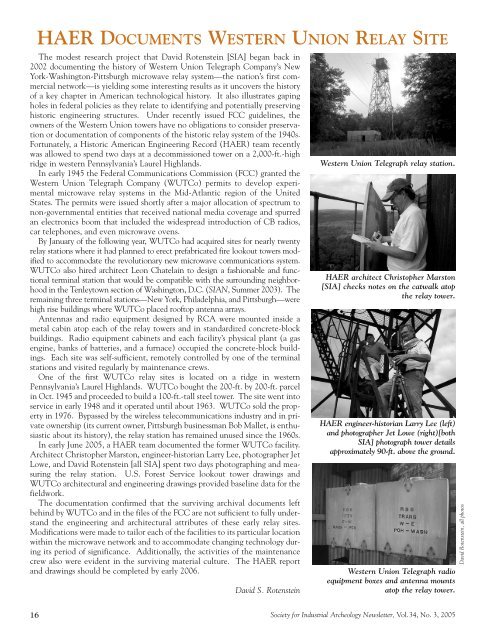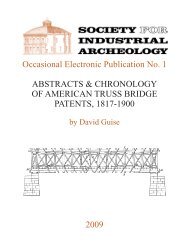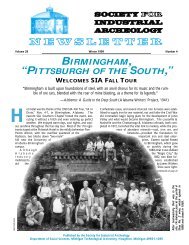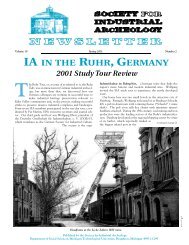SIAN - Society for Industrial Archeology
SIAN - Society for Industrial Archeology
SIAN - Society for Industrial Archeology
Create successful ePaper yourself
Turn your PDF publications into a flip-book with our unique Google optimized e-Paper software.
HAER DOCUMENTS WESTERN UNION RELAY SITE<br />
The modest research project that David Rotenstein [SIA] began back in<br />
2002 documenting the history of Western Union Telegraph Company’s New<br />
York-Washington-Pittsburgh microwave relay system—the nation’s first commercial<br />
network—is yielding some interesting results as it uncovers the history<br />
of a key chapter in American technological history. It also illustrates gaping<br />
holes in federal policies as they relate to identifying and potentially preserving<br />
historic engineering structures. Under recently issued FCC guidelines, the<br />
owners of the Western Union towers have no obligations to consider preservation<br />
or documentation of components of the historic relay system of the 1940s.<br />
Fortunately, a Historic American Engineering Record (HAER) team recently<br />
was allowed to spend two days at a decommissioned tower on a 2,000-ft.-high<br />
ridge in western Pennsylvania’s Laurel Highlands.<br />
In early 1945 the Federal Communications Commission (FCC) granted the<br />
Western Union Telegraph Company (WUTCo) permits to develop experimental<br />
microwave relay systems in the Mid-Atlantic region of the United<br />
States. The permits were issued shortly after a major allocation of spectrum to<br />
non-governmental entities that received national media coverage and spurred<br />
an electronics boom that included the widespread introduction of CB radios,<br />
car telephones, and even microwave ovens.<br />
By January of the following year, WUTCo had acquired sites <strong>for</strong> nearly twenty<br />
relay stations where it had planned to erect prefabricated fire lookout towers modified<br />
to accommodate the revolutionary new microwave communications system.<br />
WUTCo also hired architect Leon Chatelain to design a fashionable and functional<br />
terminal station that would be compatible with the surrounding neighborhood<br />
in the Tenleytown section of Washington, D.C. (<strong>SIAN</strong>, Summer 2003). The<br />
remaining three terminal stations—New York, Philadelphia, and Pittsburgh—were<br />
high rise buildings where WUTCo placed rooftop antenna arrays.<br />
Antennas and radio equipment designed by RCA were mounted inside a<br />
metal cabin atop each of the relay towers and in standardized concrete-block<br />
buildings. Radio equipment cabinets and each facility’s physical plant (a gas<br />
engine, banks of batteries, and a furnace) occupied the concrete-block buildings.<br />
Each site was self-sufficient, remotely controlled by one of the terminal<br />
stations and visited regularly by maintenance crews.<br />
One of the first WUTCo relay sites is located on a ridge in western<br />
Pennsylvania’s Laurel Highlands. WUTCo bought the 200-ft. by 200-ft. parcel<br />
in Oct. 1945 and proceeded to build a 100-ft.-tall steel tower. The site went into<br />
service in early 1948 and it operated until about 1963. WUTCo sold the property<br />
in 1976. Bypassed by the wireless telecommunications industry and in private<br />
ownership (its current owner, Pittsburgh businessman Bob Mallet, is enthusiastic<br />
about its history), the relay station has remained unused since the 1960s.<br />
In early June 2005, a HAER team documented the <strong>for</strong>mer WUTCo facility.<br />
Architect Christopher Marston, engineer-historian Larry Lee, photographer Jet<br />
Lowe, and David Rotenstein [all SIA] spent two days photographing and measuring<br />
the relay station. U.S. Forest Service lookout tower drawings and<br />
WUTCo architectural and engineering drawings provided baseline data <strong>for</strong> the<br />
fieldwork.<br />
The documentation confirmed that the surviving archival documents left<br />
behind by WUTCo and in the files of the FCC are not sufficient to fully understand<br />
the engineering and architectural attributes of these early relay sites.<br />
Modifications were made to tailor each of the facilities to its particular location<br />
within the microwave network and to accommodate changing technology during<br />
its period of significance. Additionally, the activities of the maintenance<br />
crew also were evident in the surviving material culture. The HAER report<br />
and drawings should be completed by early 2006.<br />
David S. Rotenstein<br />
Western Union Telegraph relay station.<br />
HAER architect Christopher Marston<br />
[SIA] checks notes on the catwalk atop<br />
the relay tower.<br />
HAER engineer-historian Larry Lee (left)<br />
and photographer Jet Lowe (right)[both<br />
SIA] photograph tower details<br />
approximately 90-ft. above the ground.<br />
Western Union Telegraph radio<br />
equipment boxes and antenna mounts<br />
atop the relay tower.<br />
16 <strong>Society</strong> <strong>for</strong> <strong>Industrial</strong> <strong>Archeology</strong> Newsletter, Vol.34, No. 3, 2005<br />
David Rotenstein, all photos






